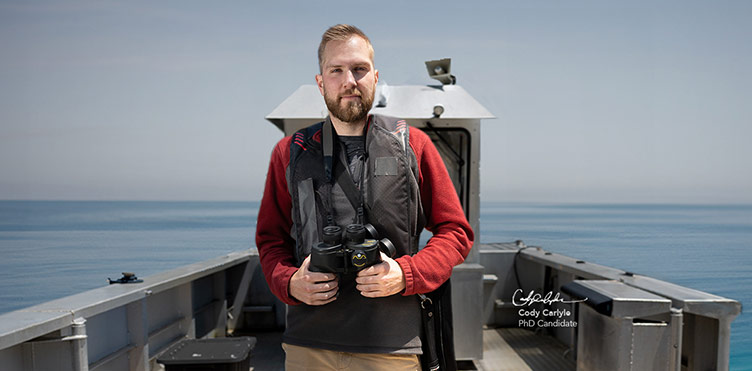
Growing up on the Pacific coast in British Columbia, just outside Vancouver, meant Cody Carlyle grew up in a family whose time together was spent fishing, camping, and being out on the water.
This outdoorsy, ocean-filled upbringing made a career in marine biology a natural choice. Carlyle had fallen in love with the water, and the creatures beneath its surface.
“I love all ocean creatures and the marine environment in general, but I got really fascinated with whales, seals, sea lions, and other marine mammals,” he says. “They're kind of elusive. They're here one moment, and then they're gone. Trying to learn about them when we can't just pin them down was challenging to me.”
Carlyle’s academic journey has taken him across Canada. It began at the University of British Columbia, where he earned an undergraduate degree in marine biology. It then brought him east to the University of Manitoba, where he earned a master’s degree and studied seals via a research partnership in the Arctic.
His journey then brought him even further east, to the University of New Brunswick (UNB), where he is now a PhD candidate. Carlyle studies right whales with Dr. Kim Davies, who leads the Davies Lab in Conservation Oceanography and Marine Technology at UNB’s Saint John campus.
The Davies Lab is industry leading, and includes internationally-renowned researchers who study endangered right whales and develop solutions to protect and support their diminishing population. It’s where Carlyle leads cutting-edge work that uses enhanced technology like satellite imagery to better understand and protect right whales.
“I’m working on testing and seeing how well this new satellite imagery works for detecting and finding whales and how we can use it for monitoring whales, censusing whales, or getting population information about whales,” says Carlyle. “[It] gets to about 30 centimetres resolution, which is incredible for a satellite that's hundreds of kilometres in the sky. That is good enough to allow us to see whales in imagery.”
There are many reasons that Carlyle says UNB in Saint John is a great place to live and do research. Among them are his love of the smaller campus and how it allows him to work closely with supportive colleagues. Another is Dr. Davies, whose world-renowned research and drive to change the world draws students like him to UNB.
“As a researcher, your lab and the professor you work with carry a lot of weight in your decision about where to go. She's very supportive and a really good person to be around to help develop a career,” says Carlyle.